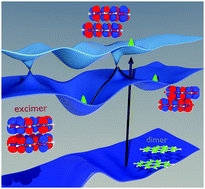当前位置:
X-MOL 学术
›
Phys. Chem. Chem. Phys.
›
论文详情
Our official English website, www.x-mol.net, welcomes your
feedback! (Note: you will need to create a separate account there.)
The mechanism of excimer formation: an experimental and theoretical study on the pyrene dimer
Physical Chemistry Chemical Physics ( IF 2.9 ) Pub Date : 2017-08-30 00:00:00 , DOI: 10.1039/c7cp03990e Joscha Hoche 1, 2, 3, 4 , Hans-Christian Schmitt 1, 2, 3, 4 , Alexander Humeniuk 1, 2, 3, 4 , Ingo Fischer 1, 2, 3, 4 , Roland Mitrić 1, 2, 3, 4 , Merle I. S. Röhr 1, 2, 3, 4
Physical Chemistry Chemical Physics ( IF 2.9 ) Pub Date : 2017-08-30 00:00:00 , DOI: 10.1039/c7cp03990e Joscha Hoche 1, 2, 3, 4 , Hans-Christian Schmitt 1, 2, 3, 4 , Alexander Humeniuk 1, 2, 3, 4 , Ingo Fischer 1, 2, 3, 4 , Roland Mitrić 1, 2, 3, 4 , Merle I. S. Röhr 1, 2, 3, 4
Affiliation

|
The understanding of excimer formation in organic materials is of fundamental importance, since excimers profoundly influence their functional performance in applications such as light-harvesting, photovoltaics or organic electronics. We present a joint experimental and theoretical study of the ultrafast dynamics of excimer formation in the pyrene dimer in a supersonic jet, which is the archetype of an excimer forming system. We perform simulations of the nonadiabatic photodynamics in the frame of TDDFT that reveal two distinct excimer formation pathways in the gas-phase dimer. The first pathway involves local excited state relaxation close to the initial Franck–Condon geometry that is characterized by a strong excitation of the stacking coordinate exhibiting damped oscillations with a period of 350 fs that persist for several picoseconds. The second excimer forming pathway involves large amplitude oscillations along the parallel shift coordinate with a period of ≈900 fs that after intramolecular vibrational energy redistribution leads to the formation of a perfectly stacked dimer. The electronic relaxation within the excitonic manifold is mediated by the presence of intermolecular conical intersections formed between fully delocalized excitonic states. Such conical intersections may generally arise in stacked π-conjugated aggregates due to the interplay between the long-range and short-range electronic coupling. The simulations are supported by picosecond photoionization experiments in a supersonic jet that provide a time-constant for the excimer formation of around 6–7 ps, in good agreement with theory. Finally, in order to explore how the crystal environment influences the excimer formation dynamics we perform large scale QM/MM nonadiabatic dynamics simulations on a pyrene crystal in the framework of the long-range corrected tight-binding TDDFT. In contrast to the isolated dimer, the excimer formation in the crystal follows a single reaction pathway in which the initially excited parallel slip motion is strongly damped by the interaction with the surrounding molecules leading to the slow excimer stabilization on a picosecond time scale.
中文翻译:

准分子形成机理:the二聚体的实验和理论研究
理解准分子在有机材料中的形成具有根本的重要性,因为准分子会极大地影响其在光收集,光伏或有机电子等应用中的功能性能。我们提出了联合实验和理论研究的超音速喷气中im二聚体中准分子形成的超快动力学,这是准分子形成系统的原型。我们在TDDFT框架中进行了非绝热光动力学的模拟,揭示了气相二聚体中两个不同的受激准分子形成途径。第一条途径涉及接近初始弗兰克-康登几何学的局部激发态弛豫,其特征是对叠层坐标的强烈激发,表现出衰减的振荡,持续时间为350皮秒,持续数微微秒。第二个准分子形成途径涉及沿平行位移坐标的大振幅振荡,周期约为≈900 fs,在分子内振动能量重新分配后,形成了完美堆叠的二聚体。激子流形内的电子弛豫是由完全离域的激子态之间形成的分子间锥形相交介导的。由于长距离和短距离电子耦合之间的相互作用,这种圆锥形相交通常会出现在堆叠的π共轭聚集体中。超音速喷气机中的皮秒光电离实验为模拟提供了支持,该实验为约6-7 ps的准分子形成提供了时间常数,与理论相符。最后,为了探索晶体环境如何影响准分子形成动力学,我们在pyr校正的紧密结合TDDFT框架内对a晶体进行了大规模QM / MM非绝热动力学模拟。与孤立的二聚体相反,晶体中的准分子形成遵循单一反应路径,其中最初激发的平行滑移运动由于与周围分子的相互作用而受到强烈抑制,从而导致皮秒级的准分子稳定。
更新日期:2017-09-20
中文翻译:

准分子形成机理:the二聚体的实验和理论研究
理解准分子在有机材料中的形成具有根本的重要性,因为准分子会极大地影响其在光收集,光伏或有机电子等应用中的功能性能。我们提出了联合实验和理论研究的超音速喷气中im二聚体中准分子形成的超快动力学,这是准分子形成系统的原型。我们在TDDFT框架中进行了非绝热光动力学的模拟,揭示了气相二聚体中两个不同的受激准分子形成途径。第一条途径涉及接近初始弗兰克-康登几何学的局部激发态弛豫,其特征是对叠层坐标的强烈激发,表现出衰减的振荡,持续时间为350皮秒,持续数微微秒。第二个准分子形成途径涉及沿平行位移坐标的大振幅振荡,周期约为≈900 fs,在分子内振动能量重新分配后,形成了完美堆叠的二聚体。激子流形内的电子弛豫是由完全离域的激子态之间形成的分子间锥形相交介导的。由于长距离和短距离电子耦合之间的相互作用,这种圆锥形相交通常会出现在堆叠的π共轭聚集体中。超音速喷气机中的皮秒光电离实验为模拟提供了支持,该实验为约6-7 ps的准分子形成提供了时间常数,与理论相符。最后,为了探索晶体环境如何影响准分子形成动力学,我们在pyr校正的紧密结合TDDFT框架内对a晶体进行了大规模QM / MM非绝热动力学模拟。与孤立的二聚体相反,晶体中的准分子形成遵循单一反应路径,其中最初激发的平行滑移运动由于与周围分子的相互作用而受到强烈抑制,从而导致皮秒级的准分子稳定。











































 京公网安备 11010802027423号
京公网安备 11010802027423号